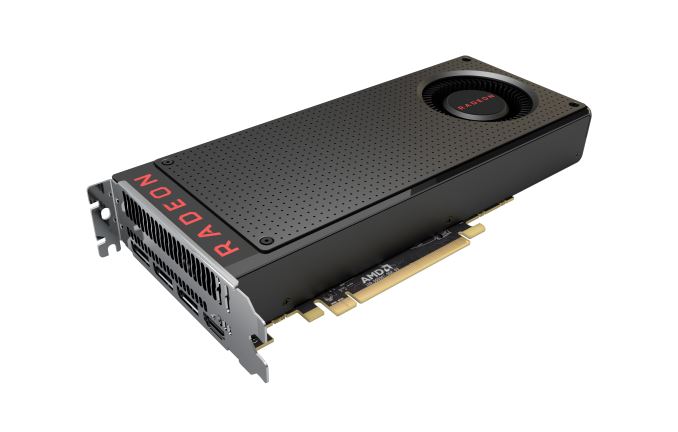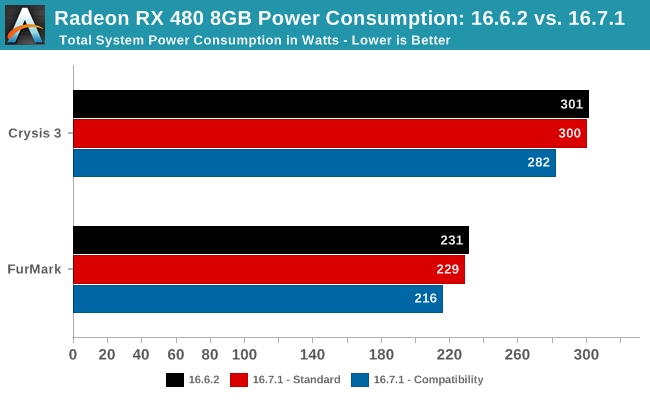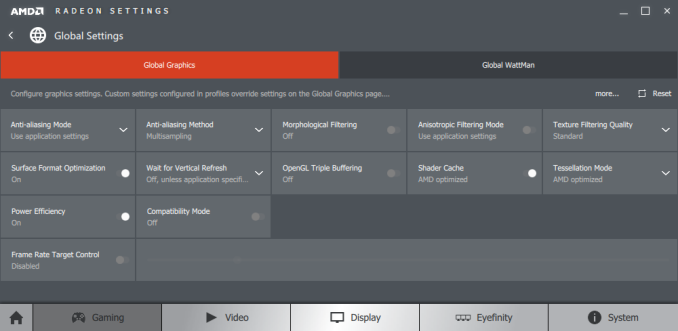AMD Posts Radeon 16.7.1 Drivers, Fixes RX 480 Power Consumption Issues
by Ryan Smith on July 7, 2016 6:50 PM EST
In what’s hopefully the final chapter on AMD’s saga over the last week with the Radeon RX 480’s power consumption, AMD has posted the previously promised 16.7.1 driver set on their website.
As a reminder, 16.7.1 is being released first and foremost to address RX 480’s power consumption issues, in which reviewers found that it was drawing too much power from the PCIe graphics (PEG) slot, and that the total power consumption of the card was at times exceeding 150W, which is the technical limit for a card with a 6-pin power connector. Of the two issues, PEG power consumption is arguably the greater of the two, as the external power connectors are far more forgiving.
To that end, 16.7.1 rolls out a two tier solution to the problem.
- Shift some of the power load off of the PCIe Graphics (PEG) slot connector in order to bring PEG slot power consumption within the PCIe spec. This doesn’t reduce total power consumption and performance is unaffected; power delivery is merely shifted. Based on earlier data this will put the 6-pin connector further over spec, but the vast majority of PSUs are very tolerant of this going out of spec.
- Because total power consumption of RX 480 can still exceed 150W – and as a result also exceed the limits for the 6-pin connector – AMD has also implemented an optional a “compatibility” toggle that reduces the total power consumption of the card. This is to better ensure that both the PEG slot and 6-pin power connector stay below their respective limits. Since the RX 480 is already throttling at times due to power limits, this does hurt performance (more on that below), but it's also the most standards-compliant solution.
Along with the power changes, the driver also incorporates some previously scheduled bug fixes and performance improvements. This includes fixing GTA V stuttering, and small performance boosts for a limited number of games that AMD states should improve performance by up to 3%.
Finally, the 16.7.1 driver can be found on AMD’s website. Note that the driver itself is not WHQL certified, but given AMD’s rush to get it out ASAP, I don’t imagine they were interested in waiting for WHQL certification to come back before releasing them.
Diving into matters then, PC Perspective has already taken a look at the new driver and done individual power rail measurements, finding that AMD’s fixes work more-or-less as advertised. They have found some edge cases where the card is still drawing a watt or two more power from the PEG slot than the specification allows, though at this point we’re arguing over inches. It should be noted however that even in compatibility mode, PC Perspective is still finding that power consumption is technically exceeding 75W on the 6-pin connector, though like the PEG slot by notably less than when not using compatibility mode.
Meanwhile to look at the performance impact of the new driver, I quickly ran our RX 480 through a selection of games at 2560x1440, both with and without compatibility mode.

In standard mode where power consumption isn’t curtailed, performance is essentially unchanged outside of Tomb Raider, which is one of the games targeted for optimization. Essentially this proves that there’s no performance impact from merely shifting power consumption off of the PEG slot to the 6-pin power connector.
Meanwhile in compatibility mode, there is a very small performance hit, though it varies with the game. Compared to standard mode, we’re looking at no more than a 1fps performance drop (~3%), with some games losing only a fraction of a frame per second. That there is a performance drop is consistent – so compatibility mode isn’t free – but overall the performance change is within the +/- 2% margin of error for these benchmarks.

Finally, when it comes to power consumption, measurements at the wall back up our earlier findings. In standard mode, power consumption at the wall bobbles by a couple of watts compared to the 16.6.2 drivers. With compatibility mode on, we see power consumption drop by 18W under Crysis 3, and 13W under FurMark. The average GPU clockspeed in both cases is similarly reduced, with Crysis 3 shaving off around 50MHz.
Anyhow, we’ll have a bit more on the subject in next week’s full Radeon RX 480 review. But in the meantime it looks like AMD has been able to get a handle on their power problems and largely rectify them within the span of a week, making for a fairly quick recovery on the RX 480’s launch fumble.











105 Comments
View All Comments
miribus - Friday, July 8, 2016 - link
If AMD connected all of the power and ground wires on their end, use a 6+2 connector instead of a 6 and you're within spec.ACE76 - Monday, July 11, 2016 - link
Just about every person who buys an enthusiast videocard overclocks them to some degree for performance...that immediately puts the card out of spec anyway...this whole thing was blown out of proportionmaccorf - Friday, July 8, 2016 - link
Did AMD kill your dog or something?Outlander_04 - Friday, July 8, 2016 - link
Thats because their was no issue apart from in the minds of a couple of reviewers and some nvidia fans .PCI-e x 16 slots are electrically good for 300 watts , and the RX 480 was certified as it was.
Once you also know that the same 6 wires of an 8 pin pci-e power connector are rated at 150 watts [ the other two do not carry current for thee card to consume] then you can see that this really is a problem only to the uninformed, and no ones motherboard was ever at risk
wolrah - Friday, July 8, 2016 - link
"PCI-e x 16 slots are electrically good for 300 watts , and the RX 480 was certified as it was."Incorrect. A PCIe card can consume up to 300 watts and be within spec, but only 75 of that can come from the slot. Quoting a PCI-SIG presentation by an Intel engineer:
A 300W add-in card can receive power by the following
methods:
* 75W from x16 PCIe connector plus 150W from a 2x4 connector plus 75W from a 2x3 connector.
* 75W from x16 PCIe connector plus 75W from a first 2x3 connector, plus 75W from a second 2x3 connector, plus 75W from a third 2x3 connector.
** Note that this is not the preferred approach.
There is a configuration parameter in the PCIe spec that lets the card tell the host it'll be using 300 watts and some AMD fanboys have run with that saying the spec allows 300 watts from the slot itself.
wolrah - Friday, July 8, 2016 - link
You are of course technically correct that they're still violating the spec, but come on. That power's already coming from the power supply one way or another. The actual load on it doesn't change. All that changes is it's now being routed over a dedicated set of cables with big connectors designed to carry many amps rather than tiny edge connector pins.They went from violating the spec in a way that legitimately mattered to doing so in a way that really doesn't. It's like the difference between doing 90 MPH while weaving through heavy traffic and doing 90 MPH on an empty freeway at 3 AM. They're both equally against the applicable rules but one is clearly risky where the other one pretty much isn't.
ACE76 - Monday, July 11, 2016 - link
Yeah, maybe your PSU can't handle the power draw but for 99.9% of other systems, this fix will do just fine.HighTech4US - Thursday, July 7, 2016 - link
The RX 480 is still non-compliant on the PCI-e connector even in compatibility mode (which is OFF by default).http://www.pcper.com/reviews/Graphics-Cards/AMD-Ra...
Quote: With the original launch driver we saw the PEG slot pulling 6.8A or more, with the 6-pin pulling closer to 6.6A. On 16.7.1 the PEG slot draw rate drops to 6.1-6.2A. Again, that is still above the 5.5A rated maximum for the slot.
Quote: Current still doesn’t make it down to 5.5A in our testing, but the PEG slot is now pulling 5.75A in our worst case scenario, more than a full amp lower than measured with the 16.6.2 launch driver
So you have two choices: 10.9% or 4.5% non-compliant.
RussianSensation - Thursday, July 7, 2016 - link
The 75W rating for 6-pin and 150W rating for the 8-pin are not true ratings.The six-pin connector uses two +12 V wires to carry up to 75 W, whereas the eight-pin connector uses three +12 V wires to carry up to 150 W. Although these figures are what the specifications allow, the wires and terminals of each connector are technically capable of handling much more power. Each pin in the PCI Express auxiliary power connectors is rated to handle up to 8 amps of current using standard terminals—more if using HCS or Plus HCS terminals. By counting the number of terminals, you can calculate the power-handling capability of the connector.
PCIe power compliance as 6-pin and 8-pin are rated to draw much more power than their paper spec. R9 295X2 is only rated at 375W using the useless compliance rating but can draw 500W+ with ease without anything blowing up. I know because I've been running the card 100% loaded for months at a time without issues. 85-91W from the 6-pin connector is nothing.
If you actually looked up the detailed specs for 6-pin graphics connector, you'd see that most modern PSUs made in the last 10 years can provide 192-288W of power for it:
http://www.tomshardware.co.uk/power-supply-specifi...
It's amazing how the entire Internet has now become 'experts' on power supplies and PCIe slots without actually doing any research on the topic.
Oxford Guy - Friday, July 8, 2016 - link
"It's amazing how the entire Internet has now become 'experts' on power supplies and PCIe slots without actually doing any research on the topic."Why miss out on the opportunity to clutch one's pearls when it comes to AMD?
Nonetheless, it seems evident that products should be reigned in to fit the stated specifications. If those are too conservative then they need to be changed.